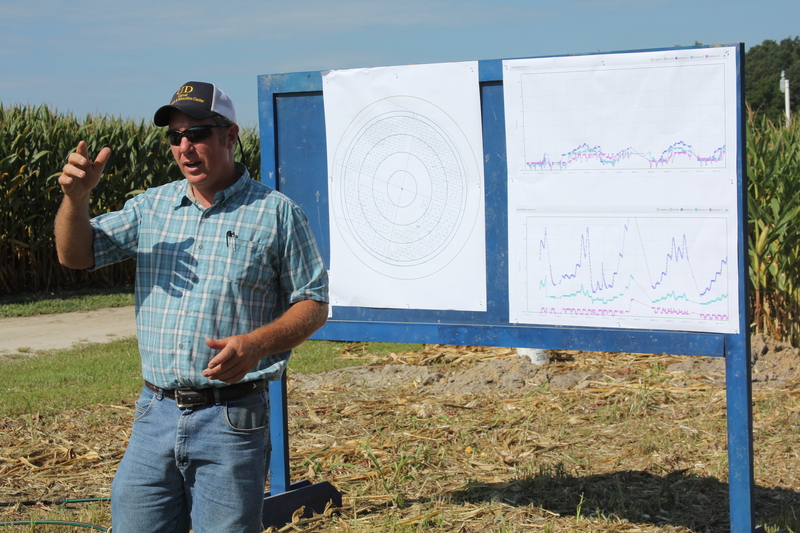Beneath the corn fields of a Harbeson farm, a network of underground pipes pump water to the harvest, part of a University of Delaware project studying how underground irrigation could work on Delaware farms.
On Aug. 20, farmers and scientists gathered at the Warrington Irrigation Research Farm to hear the latest research about subsurface irrigation and its affects on crop yields.
Sponsored by the University of Delaware College of Agriculture and Natural Resources and Delaware Cooperative Extension, researchers gave an overview of a 16-acre subsurface drip irrigation system installed on the research property and update the second year of a 20-year project to determine if the system can benefit Delaware farmers.
“The process developed out of the need for farmers to learn about managing drip systems,” said James Adkins, irrigation engineer for the University of Delaware.
The research facility installed the underground irrigation lines over fields with different types of soil composition to see how it works. So far, research shows subsurface irrigation works better in soil with a combination of clay and sand works than in sandy soil. In all cases, underground irrigation only works when the top 12 inches of soil is moist, Adkins said. If the top soil dries out, plants are unable to pull up water from the underground channels; farmers must consider above ground irrigation in years that rainfall is sparse, he said.
However, last summer's 26 inches of rain turned out to be too much. The ground absorbed only 9 inches of water while the rest ran off, as did much of the fertilizer, he said.
Because of this, the research facility's corn yield was better during drier spells than during heavy rainfall, Adkins said.
“There were severe nitrogen deficiencies,” he said. “It definitely hurt our yield from all the rainfall last year.”
This year's rainfall is about normal, according almanac statistics. For the month, rainfall is slightly up with 3.94 inches compared to a normal month of 3.76 inches. For the year, it is slightly less with 29.62 inches compared to 29.86 for a normal year.
Bugs and rodents can also damage underground irrigation lines, especially those made of thinner plastic.
Wireworms can drill through 8 mm plastic irrigation lines; rodents are naturally drawn to water, he said.
“We had a groundog around here, but he's not around anymore,” Adkins said to a burst of laughter from the group. “You need a very intensive rodent control program.”
Adkins said there are about a dozen farmers throughout Sussex County using subsurface irrigation systems. The underground system can help farmers irrigate their entire property, especially corner areas that a circular, above-ground system will miss, he said. Wire theft is reduced by using underground plastic irrigation lines and there is definitely less energy used; depending on the type of soil, less water could be used as well, Adkins said.
Cost, however, remains a consideration for some farmers. Adkins said a deep drip system dug 16 inches below the surface can cost $1,500 to $2,200 per acre, depending on the type of soil.
Milton farmer Cheryl Ockels, whose family owns thousands of acres of farmland, said they use an underground system for about 100 acres. It works great for small parcels of land that cannot hold an above ground sprinkler system, she said.
“We love it,” Ockels said. “It works very well.”
She said the family plans to install more systems in the future and they have recommended the subsurface drip irrigation system to others.
Melissa Steele is a staff writer covering the state Legislature, government and police. Her newspaper career spans more than 30 years and includes working for the Delaware State News, Burlington County Times, The News Journal, Dover Post and Milford Beacon before coming to the Cape Gazette in 2012. Her work has received numerous awards, most notably a Pulitzer Prize-adjudicated investigative piece, and a runner-up for the MDDC James S. Keat Freedom of Information Award.
























































